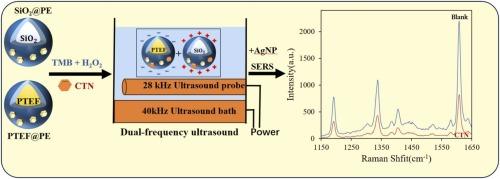Di-frequency ultrasound synergistic activation of two piezoelectric catalysts for SERS determination of ultratrace chlorothalonil
IF 3.7
1区 化学
Q1 CHEMISTRY, ANALYTICAL
引用次数: 0
Abstract
Ultrasound-driven piezoelectric enhancement is interesting to scientists. These effects are used to fabricate piezoelectric nanogenerator (PENG) and triboelectric nanogenerator (TENG) for energy harvesting and self-powered sensing. There are no reports about di-frequency ultrasound piezoelectric nanocatalysts in water phase, and their application to SERS quantitative analysis. Therefore, developing a selective and sensitive ultrasound piezoelectric nanocatalysts-SERS method is of great importance. In this study, using piezoelectric nanoquartz (SiO₂) and polytetrafluoroethylene (PTFE) as substrates, chlorothalonil (CTN) as template molecule, and poly(3,4-ethylenedioxythiophene) (PE) as the molecularly imprinted layer, two new nanosurface molecularly imprinted polymer nanocatalysts of SiO₂@PE and PTFE@PE were synthesized via a solvothermal procedure. Under simultaneously applied dual-frequency ultrasonic irradiation (28/80 kHz), the two nanocatalysts significantly enhanced the electron transfer in the 3,3′,5,5′-tetramethylbenzidine (TMB)–H₂O₂ reaction, producing the oxidized TMB (TMBox) with strong SERS activity. Binding of CTN to the probe inhibited the catalysis, resulting in the SERS signal decreasing linearly. This strategy notably improved detection sensitivity, increasing the slope ratio of 42.7 times, with detection limit of 5 pmol/L CTN. Based on the results, a reasonable difrequency ultrasound piezoelectric nanocatalytic enhanced mechanism was proposed.

两种压电催化剂的双频超声协同活化SERS测定超痕量百菌清
超声波驱动的压电增强技术引起了科学家们的兴趣。利用这些效应制备了用于能量收集和自供电传感的压电纳米发电机(PENG)和摩擦电纳米发电机(TENG)。水相双频超声压电纳米催化剂及其在SERS定量分析中的应用尚未见报道。因此,开发一种选择性高、灵敏度高的超声压电纳米催化剂- sers方法具有重要意义。本研究以压电纳米石英(SiO₂)和聚四氟乙烯(PTFE)为底物,百菌清(CTN)为模板分子,聚(3,4-乙烯二氧噻吩)(PE) (PE)为分子印迹层,通过溶剂热法合成了两种新型的纳米表面分子印迹聚合物纳米催化剂SiO₂@PE和PTFE@PE。在双频超声同时照射下(28/80 kHz),两种纳米催化剂显著增强了3,3',5,5'-四甲基联苯胺(TMB) -H₂O₂反应中的电子转移,生成了具有较强SERS活性的氧化TMB (TMBox)。CTN与探针的结合抑制了催化作用,导致SERS信号线性下降。该策略显著提高了检测灵敏度,斜率比提高了42.7倍,检出限为5 pmol/L CTN。在此基础上,提出了一种合理的双频超声压电纳米催化强化机理。
本文章由计算机程序翻译,如有差异,请以英文原文为准。
求助全文
约1分钟内获得全文
求助全文
来源期刊

Sensors and Actuators B: Chemical
工程技术-电化学
CiteScore
14.60
自引率
11.90%
发文量
1776
审稿时长
3.2 months
期刊介绍:
Sensors & Actuators, B: Chemical is an international journal focused on the research and development of chemical transducers. It covers chemical sensors and biosensors, chemical actuators, and analytical microsystems. The journal is interdisciplinary, aiming to publish original works showcasing substantial advancements beyond the current state of the art in these fields, with practical applicability to solving meaningful analytical problems. Review articles are accepted by invitation from an Editor of the journal.
 求助内容:
求助内容: 应助结果提醒方式:
应助结果提醒方式:


